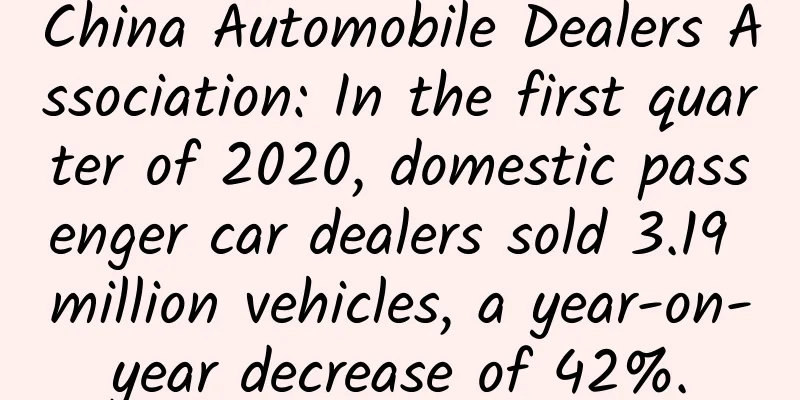China Automobile Dealers Association: In the first quarter of 2020, domestic passenger car dealers sold 3.19 million vehicles, a year-on-year decrease of 42%.

|
In the first quarter of 2020, domestic passenger car dealers sold 3.19 million vehicles, down 42% year-on-year, and 2.27 million fewer vehicles than the same period last year; among them, 20 luxury car dealers sold 518,000 vehicles, down 26% year-on-year, and 180,000 fewer vehicles than the same period last year. In March, domestic passenger car dealers sold 1.14 million vehicles, down 33% year-on-year and up 45 percentage points month-on-month; 20 luxury car dealers sold 209,000 vehicles, down 17% year-on-year and up 54 percentage points month-on-month. Sales data for the first quarter showed that luxury cars have become the most resilient sector in overall auto sales, with first-tier cities and eastern and southern regions becoming the main areas for luxury car sales growth . According to data from the Circulation Association, as of the end of March, the resumption rate of dealer stores across the country reached 95.5%, the customer flow recovery rate reached 64.0%, and the sales efficiency reached 61.7%. Compared with the end of February, the resumption rate increased by 65.5 percentage points and the sales efficiency increased by 39.7 percentage points. The overall recovery of the domestic automobile retail sector is relatively ideal, which will help to further increase sales in April. In the first quarter, the epidemic had a significant impact on the overall domestic economy. According to data from the National Bureau of Statistics, the GDP in the first quarter was 20650.4 billion yuan, a year-on-year decrease of 6.8% at comparable prices. In the first quarter, the per capita disposable income of residents nationwide was 8,561 yuan, a nominal increase of 0.8% year-on-year, and a real decrease of 3.9% after deducting price factors; during the same period, the national consumer price index rose by 4.9% year-on-year. In the first quarter, the total retail sales of consumer goods was 785.8 billion yuan, a nominal decrease of 19.0% year-on-year; in March, the total retail sales of consumer goods was 264.5 billion yuan, a year-on-year decrease of 15.8% (actual decrease of 18.1% after deducting price factors); in the first quarter, the total retail sales of consumer goods in the automobile category fell by 30.3% year-on-year to 632.6 billion yuan; in March, the total retail sales of automobiles in the automobile category fell by 18.1% year-on-year to 260.9 billion yuan. In the first quarter, the total retail sales of luxury cars was 203.8 billion yuan, a year-on-year decrease of 30%, of which the total retail sales in March was 78.5 billion yuan, a year-on-year decrease of 18%. The decline in both domestic production and consumption has a significant impact on the automobile distribution industry. The reduction in consumer income will directly affect their confidence in purchasing major consumer goods. If the country's stimulus policies are moderate, as the economy gradually recovers, automobile consumption will also have the opportunity to gradually recover. In March, various national ministries jointly launched policies to stimulate automobile consumption, including extending the purchase subsidy and purchase tax exemption policy for new energy vehicles for two years, completely abolishing the restriction on the relocation of used cars, levying value-added tax of 0.5% of sales on used cars by used car dealers, eliminating the "old for new" policy for National III vehicles, increasing license plate resources in license-restricted cities such as Shanghai, Guangzhou, and Hangzhou, delaying the implementation of the "National VI" emission standards, lifting the restriction on pickup trucks entering cities, and various localities launching car purchase subsidies. This year, local governments have also introduced relevant policies to stimulate automobile consumption, which is rare before. Judging from the amount of subsidies provided by various places, it is equivalent to a halving of the purchase tax. However, judging from the policies introduced by Shanxi, Guangxi, Changsha, Xiangtan, Changchun, Ningbo and other places, they only encourage local consumers to buy local cars. Consumers can only enjoy subsidies if they buy local cars and register them locally. This practice is suspected of violating the Anti-Monopoly Law. Its essence is an act of discrimination, an abuse of administrative power to restrict competition, and unequal treatment of market entities with equal status under market conditions. It is not fair to other brand dealers who also pay taxes to the local area and provide local employment, and it undermines the government's credibility and fairness. The current stimulus policies only partially stimulate the auto market and have not played a positive role in promoting the overall new car sales market. The new car market urgently needs inclusive stimulus policies such as the purchase tax halving and value-added tax reduction used in the previous two stimulus policies. These policies can benefit consumers across the country. For dealers, inclusive stimulus policies actually replace the manufacturer's advertising, which can bring consumers to the store, increase the store's customer flow and drive sales. If inclusive stimulus policies are not introduced in the near future, auto consumption can only recover slowly in the second quarter, and at the end of the second quarter, automakers will adjust their sales plans for the second half of the year. Assuming that the third and fourth quarters can maintain last year's sales scale, the annual dealer retail sales are expected to fall by about 15%, about 3 million units less than last year, and sales will fall to less than 20 million units, with a total loss of about 500 billion yuan in new car retail sales. In March, Europe, the United States, Japan and other countries were affected by the epidemic. Automakers such as Mercedes-Benz, BMW, Audi, Porsche, Lexus, Volvo, Lincoln, Lamborghini, and Ferrari extended the closure of their factories to April or May, which had a certain impact on the sales of imported cars. Since the export arrival time of each imported car company to China is about N+3 months (Toyota is about 1 month), the impact on the sales of imported cars will be apparent in the next few months; in addition, domestic dealers suspended sales in February due to the epidemic, and the accumulated import inventory was released in March, so the domestic inventory of imported cars was relatively sufficient, and the actual impact on sales was not significant; in April, as Mercedes-Benz and other brands began to gradually start production in European factories, imported car resources are still relatively abundant throughout the year, and each car company is not expected to adjust its annual sales target for imported cars. In the first quarter, the market share of luxury cars was 16.2%, up 3.4 percentage points year-on-year. In March, the market share of luxury cars was 18.3%, up 3.5 percentage points year-on-year, and the market share reached a record high in recent years. In the first quarter, Mercedes-Benz, BMW, Audi, Lexus, Cadillac, and Volvo ranked first in market share; from the perspective of market segments, in the first quarter, the market share of luxury cars was 54.5%, down 1.6 percentage points year-on-year, and the market share of luxury SUVs increased by 1.6 percentage points, of which the market share of mid-size SUVs was 24.5%, up 2.8 percentage points year-on-year, driving the growth of the SUV market segment; in the first quarter, the market share of mid-size cars fell by 1.5 percentage points to 24.2%. As the two largest sales segments in the luxury car market, there is a high degree of user overlap, which is mainly affected by new products and new car prices, and sales are increasing and decreasing. Luxury car discount rates remain stable In March, the overall weighted average transaction price of the luxury car market was around 390,000 yuan, down 18,000 yuan from January, which was related to the decrease in sales of imported cars; the discount rate remained around 14.9%, down 0.3 percentage points from January, and the market price was relatively stable; car companies increased their rebate support for dealers, with rebates increasing by 0.7 percentage points compared with January; in March, luxury car companies continued the policy of February, continued to provide liquidity support to dealers, accelerated the issuance of rebate bonuses, extended the interest-free period for inventory financing, and canceled or lowered the new car sales assessment targets, etc. As the first full sales month after the end of the epidemic, various market indicators showed good trends, which laid a good foundation for the recovery of market sales in the following months. In the first quarter, passenger car sales in the 10 cities were 720,000 units, down 45% year-on-year, of which luxury car sales were 180,000 units, down 28% year-on-year. The market share of luxury cars in the 10 cities rose from 20% in the same period last year to 26%; among the 10 cities, the market share of luxury car sales in Beijing and Shenzhen increased by 10 percentage points year-on-year, Guangzhou increased by 9 percentage points, Hangzhou increased by 8 percentage points, and Suzhou and Chengdu increased by 6 percentage points. The sales data of the 10 cities show that the luxury car retail market in regional central cities has recovered faster. Consumers in these cities have relatively strong financial strength and have good expectations for the future. With the end of the epidemic, automobile consumption in regional central cities has begun to recover. In March, the luxury car market in cities such as Hangzhou, Suzhou, Chongqing, Shanghai, and Xi'an recovered faster, and luxury car sales fell by less than 13% year-on-year. In March, only the Beijing market fell by 46%, mainly affected by the epidemic, which was related to the fact that the new car inspection site was not open and new and used cars could not be traded normally. (The author selected ten regional central cities in China to observe the retail market, covering the eastern and western regions, first-tier, second-tier and third-tier markets; the 10 cities are: Beijing, Shanghai, Guangzhou, Shenzhen, Chengdu, Chongqing, Zhengzhou, Suzhou, Hangzhou and Xi'an) In the first quarter, Mercedes-Benz dealers sold 140,000 vehicles, down 23% year-on-year, with a market share of 27.1%. In the first quarter, Mercedes-Benz officially announced sales of 139,000 vehicles, down 20% year-on-year. The decline in Mercedes-Benz sales was lower than the industry average, which was related to the concentrated delivery of orders accumulated at the end of last year in the first two months of this year. According to data released by the Beijing Statistics Bureau, the value-added of Beijing's automobile manufacturing industry fell by 30.2% in the first quarter, and the city produced 295,000 vehicles, down 27.9% from the same period last year. Beijing Benz resumed work on February 10. As the best asset in Beijing's automobile industry, Beijing Benz bears the dual pressure of production and output value; data from the China Passenger Car Association in the first quarter showed that Beijing Benz sold 110,000 vehicles, accounting for 56% of BAIC Group's sales, which put great pressure on Mercedes-Benz's retail and prices. In March, the average transaction price of Mercedes-Benz new cars was 480,000 yuan, an increase of 11,000 yuan compared with the same period last year. The brand discount was about 10%, and dealers had a certain profit margin for new car sales. In the first quarter, the sales of Mercedes-Benz A-Class, GLB, and GLC L increased rapidly, sharing the sales pressure of Mercedes-Benz C-Class and E-Class, but the discount rate of these three models also increased. Among them, the sales of Mercedes-Benz A-Class increased by 31% year-on-year to 13,000 units, and the average price of new cars was about 213,000 yuan. Compared with domestic models of the same level, the price is the most expensive, but compared with March of the same period last year, the price dropped by nearly 22,000 yuan, which is related to the increase in sales and the sales ratio of models. The retail sales of the newly launched GLB exceeded 5,000 units, with an average price of about 330,000 yuan. The average price of the BMW X1 of the same level is around 250,000 yuan. There is a certain room for expansion in the sales and price of GLB. The retail sales of GLC L exceeded 31,000 units, and the discount and average sales price remained stable. The main sales force of Mercedes-Benz imported cars, GLE, sold more than 7,500 units, reaching the same level as last year, and the average sales price remained at around 790,000 yuan, which is a dealer profit model. Mercedes-Benz's retail sales in March were not high among ABBs. Affected by the epidemic in the first quarter, various automakers did not pursue sales volume. Some orders in March can be transferred to April, leaving room for sales growth in the second quarter. Beijing Benz rushed to meet production progress and did not adjust the production plan. When it comes to sales, sales pressure will appear in the second quarter, and the brand discount trend in April also proves this. If Mercedes-Benz's full-year sales target is not adjusted, and the sales progress in the first and second quarters is faster than other luxury brands, then the sales pressure in the second half of the year will be smaller than other brands. In the first quarter, BMW dealers sold 117,000 vehicles, down 29% year-on-year, with a market share of 22.5%. MINI dealers sold 4,900 vehicles, down 37% year-on-year. In the first quarter, BMW (MINI) officially announced sales of 122,000 vehicles, down 29% year-on-year. In March, the average transaction price of BMW new cars was 400,000 yuan, an increase of 44,000 yuan compared with the same period last year, and the brand discount was about 14%. The increase in the average transaction price of BMW new cars is mainly related to the continuous launch of new products in the past year. After the new 3 series was launched, the discount rebounded significantly. Imported cars including the new X5, new X7, and new 7 series have all been remodeled or replaced. The retail prices of these new cars have been greatly increased compared to the old models, which has greatly helped the recovery of the average transaction price of the BMW brand. During the shutdown period of BMW Brilliance's factory, it lost nearly 25,000 units in production. In response, BMW Brilliance adjusted its production plan in March, which helped ease the sales pressure of domestically produced BMWs. Data from the China Passenger Car Association showed that Beijing Benz's sales reached 51,000 units in March, 10,000 more than BMW Brilliance. Dealer retail sales in March showed that Mercedes-Benz sold 7,200 units fewer than BMW. This sales difference will be reflected in the second quarter, specifically in that Mercedes-Benz dealers' inventory pressure will be greater than BMW dealers' inventory pressure. In the first quarter, the sales of BMW 5 Series reached 27,000 units, down 14% year-on-year. In March, the sales of BMW 5 Series turned positive, exceeding 10,000 units, with discounts of around 12%. BMW 5 Series will usher in a mid-term facelift this year, and its product strength will be further strengthened. In the first quarter, the sales of BMW X3 fell 16% year-on-year, with sales exceeding 20,000 units. The sales in March were also close to turning positive, with the same discount as BMW 5 Series. BMW 3 Series was completely replaced at the end of last year, and monthly sales this year will remain at around 10,000 units. The average price of BMW 3 Series is currently over 300,000, an increase of more than 40,000 compared with the same period last year, and the discount remains at around 13%, which is also a significant improvement compared with before the facelift. The sales and prices of BMW's two imported models, X5 and 7 Series, also remain at a good level. BMW's sales quality in the first quarter has improved significantly compared with the same period last year. In the first quarter, Audi dealers' retail volume was 113,000 vehicles, down 25% year-on-year, with a market share of 21.8%. Audi's officially announced sales volume was consistent with dealers' retail volume. In March, the average transaction price of Audi's new cars was 290,000 yuan, down about 20,000 yuan from the same period last year, with a brand discount rate of 24%, and a stable trend. Compared with Mercedes-Benz and BMW, Audi's imported car sales are relatively low. The main sales models such as Audi Q7 have not been listed due to the epidemic. Among domestic models, small cars such as Q3, A3, and Q2L account for a higher proportion than Mercedes-Benz and BMW, which has a certain impact on the average transaction price. In terms of the average transaction price of a single model, the Audi A6L has been on the market for 5 quarters, and the average transaction price has remained at around 360,000 yuan, which is 40,000 yuan higher than the price of the previous generation A6L when it was delisted; the average price of the Mercedes-Benz E-Class of the same level is 460,000 yuan, and the average price of the BMW 5 Series is 430,000 yuan. Although the sales of the three models are relatively close, they have opened up a price range; in the mid-size SUV market segment, the average price of the Audi Q5L is maintained at around 340,000 yuan, the average price of the Mercedes-Benz GLC L is 440,000 yuan, and the average price of the BMW X3 is 370,000 yuan. The three models also have similar sales and different prices. In the first quarter, FAW Audi lost nearly 40,000 units of production due to the epidemic, so dealers were not under much sales pressure. In March, Audi gave priority to providing dealers with best-selling models such as A6L and Q5 to help dealers resume sales. In the first quarter, the sales of Audi's three main models, Audi A4L, A6L, and Q5L, exceeded 20,000 units, and the sales of Q3 and A3 exceeded 10,000 units. As for imported cars, sales fell sharply due to factors such as the epidemic, and it is expected to improve in the second quarter. In the first quarter, Cadillac dealers' retail volume was 26,000 vehicles, down 40% year-on-year, and its market share was 5.1%, down 1 percentage point from the same period last year. In the first quarter, Cadillac's officially announced sales volume was 26,800 vehicles, down 40% year-on-year. In March, the average transaction price of Cadillac's new cars was 300,000 yuan, up 20,000 yuan from the same period last year; the brand discount rate was 18%, down 2 percentage points from the same period last year. Cadillac achieved a double recovery in the transaction price and discount rate in a year, which reflects the work performance of the management team. This performance was achieved mainly by launching new cars with higher prices and renaming the new cars; compared with last year, the old ATS-L and XTS, which had a retail discount of about 30 percentage points, were withdrawn from the market and stopped selling, and two new models, CT5 and CT4, were launched. In July last year, the new medium and large SUV model CT6 was launched, priced from 419,700 yuan, which greatly helped the recovery of the brand discount rate and the average transaction price. However, the discount and average transaction price trends of the models on sale are not good. For example, compared with the same period last year, the average transaction price of the main sales model XT5 dropped from 342,000 yuan to 306,000 yuan, a decrease of 36,000 yuan. However, the discount rate trended in the opposite direction, from 25% in the same period last year to 20%, a discount of 5 percentage points. The recovery of the discount was mainly achieved by adjusting the suggested retail price of the new car. In November 2017, Cadillac released the XT5 28E four-wheel drive technology model priced at 379,900 yuan. In June 2019, the XT5 was mid-term facelifted, and the same model was priced at 349,700 yuan, with the suggested retail price reduced by more than 30,000 yuan, which greatly helped the recovery of the discount rate of XT5. For the two models Cadillac is selling, since there has not been a mid-term facelift and the manufacturer's suggested retail price has not been adjusted, the discount and average price can better reflect the real situation. The average transaction price of CT6 is 330,000 yuan, down 43,000 yuan compared with the same period last year, and the discount rate is 25%, an increase of 6 percentage points compared with the same period last year; the average transaction price of XT4 is 250,000 yuan, down 32,000 yuan compared with the same period last year, and the discount rate is 20%, an increase of 9 percentage points compared with the same period last year; It is not difficult to see from the above data that Cadillac has gradually abandoned the sales strategy of high pricing and high discounts, and began to lower the suggested retail price of new cars, reduce new car sales discounts, reduce the damage of high discounts to the brand, and gradually enhance the brand value. In the first quarter, Lexus dealers sold 32,000 vehicles, down 18% year-on-year, with a market share of 6.3%; the official sales volume was 28,000 vehicles, down 25% year-on-year. In March, the average transaction price of new Lexus cars was 410,000 yuan, down 50,000 yuan from the same period last year. This was related to the decrease in sales of more expensive models such as Lexus LX and GS. In the first quarter, from the perspective of dealers' retail sales, Lexus' sales volume declined slightly, which is related to Lexus's continued order sales. Most of the vehicles delivered in the first quarter were orders from last year and January. As long as the supply of new vehicles can be guaranteed, dealers' retail sales will not be under great pressure. In the first quarter, ES sales volume was nearly 16,000 units, down 3.2% year-on-year, NX sales volume was 6,200 units, down 4.1% year-on-year, and RX sales volume fell 35% to 6,700 units due to supply, but the average transaction price rose by 5,000 yuan. In the first quarter, the retail sales of Jaguar Land Rover's domestically produced models fell significantly, down 46% year-on-year. The launch of the domestically produced Discovery Sport facelift coincided with the epidemic, and both production and wholesale sales were affected. It is expected that sales in the second quarter will be significantly improved. In March, Jaguar Land Rover's monthly showroom traffic and orders increased significantly. The 11 measures launched for dealers, including providing epidemic prevention materials for showroom employees, canceling monthly assessments, providing inventory subsidies, launching comprehensive online marketing training, etc., effectively alleviated the pressure on dealer partners in epidemic prevention and control and business operations. At present, Jaguar Land Rover's dealers in China have basically resumed operations across the network. In the first quarter, Volvo dealers sold 23,000 vehicles, down 28% year-on-year, and the official sales volume was 20,000 vehicles, down 31% year-on-year. In the first quarter, Volvo's market share was 4.4%, and the average brand price was 330,000 yuan. In the first quarter, Porsche dealers sold 15,000 vehicles, a year-on-year decline of 10%. Among them, sales in March were 6,600 units, a year-on-year increase of 51%, and sales began to pick up. In the first quarter, Porsche took a number of measures such as accelerating rebates and financial support to help dealers improve cash flow and increase liquidity. In terms of new car delivery, more popular models are provided to dealers, so that consumers can quickly pick up the reserved cars from dealers, helping dealers resume new car sales. In addition, Porsche China maintains communication and consultation with dealers on core indicators that affect the healthy operation of dealers, such as adjustment of spare parts procurement targets, new car wholesale sales, and rebate issuance, based on the specific recovery of the market. In the first quarter, Lincoln dealers sold 6,300 vehicles, down 28% year-on-year; in March, sales were 2,735 vehicles, down 30% year-on-year. In the first quarter, Lincoln's market share was 1.2%, and the average brand price was 400,000 yuan. In the second quarter, the domestically produced Aviator will enter full-season sales, which will help boost Lincoln's brand sales. In the first quarter, Infiniti dealers sold 4,400 vehicles, a year-on-year decline of 55%. In March, sales were 1,800 vehicles, a year-on-year decline of 51%. In the first quarter, Infiniti's market share was 1.2%, and the average brand price was 300,000 yuan. In the first quarter, Maserati dealers sold 590 vehicles, down 68% year-on-year. In March, sales were 230 vehicles, down 35% year-on-year. In the first quarter, Acura dealers sold 1,844 vehicles, down 36% year-on-year; in March, sales were 795 vehicles, down 18% year-on-year. In March, Tesla sold 13,000 vehicles, of which domestically produced Model 3 accounted for 88%; the top ten cities accounted for 98% of the total sales, and Tesla sales were concentrated in medium and large cities; Shanghai sold more than 3,000 units; Beijing, Hangzhou, Guangzhou, and Shenzhen sold more than 1,000 units, and Beijing sold nearly 1,800 units; Chengdu and Suzhou, cities without purchase restrictions, sold more than 500 units; Nanjing, Ningbo, Chongqing, Tianjin, Xi'an, Qingdao, and Xiamen sold more than 300 units. March is Tesla's key month for quarterly delivery. Previously, the domestically produced car reservation collection started on June 1, 2019, and the batches were delivered in March; the current Model 3 reservation can be delivered within 2-4 weeks, and Tesla launched a financial promotion policy in April, indicating that order acquisition is currently the top priority. |
<<: Is there any possibility for the marginalized second-rate video websites to revive?
>>: Create a father for yourself: How Google changed the world again
Recommend
One trick cost 150,000 yuan in advertising fees! Do you still dare to use these information flow copywriting?
In the past week, nine home improvement companies...
2021 Clothing Brands Q1-Q3 Social Media Marketing Analysis Report
Under the influence of factors such as consumptio...
What fruit juice contains up to 80% sugar?
The national emblem of Saudi Arabia looks like th...
Volkswagen may be numb to the lawsuit again
According to foreign media reports, the state of ...
10 Top Ten Effective Traffic Drainage Solutions, Take It!
Private domain operations rely on traffic generat...
How long does it take to make an app like this?
[[142904]] I was holding the water cup somewhat a...
Tieba's wireless post-uploading technology without post deletion can attract more than 500 users per day
Today, Dongguan SEO-Feng Chao is here to share wi...
Will drinking edamame cause bone deformation? These things are the culprit
There was a news recently: An old man liked to ea...
The poisonous C position debuts in the mammal world! Platypus: I am a professional at stabbing people
Ding ding ding ~ Fantastic beasts are coming! Tad...
Kang Zhijun's "The Human Side of Enterprise" Intensive Study Class
Kang Zhijun's "The Human Side of Enterpr...
Selling 196 million in one day, how did Himalaya achieve growth?
Himalaya was established in 2012. Its previous po...
XcodeGhost malware updated to target iOS 9
By repackaging Xcode and tricking developers into...
How to promote WeChat mini programs? What can it bring to us?
I have been chatting with many friends recently, ...
How much does it cost to attract investment in Huangshan Machinery Equipment Mini Program?
Is it easy to attract investment for Huangshan Me...
Regain Flexibility 2.0 Baidu Cloud Download
Regain Flexibility 2.0 Resource Overview: Course ...









